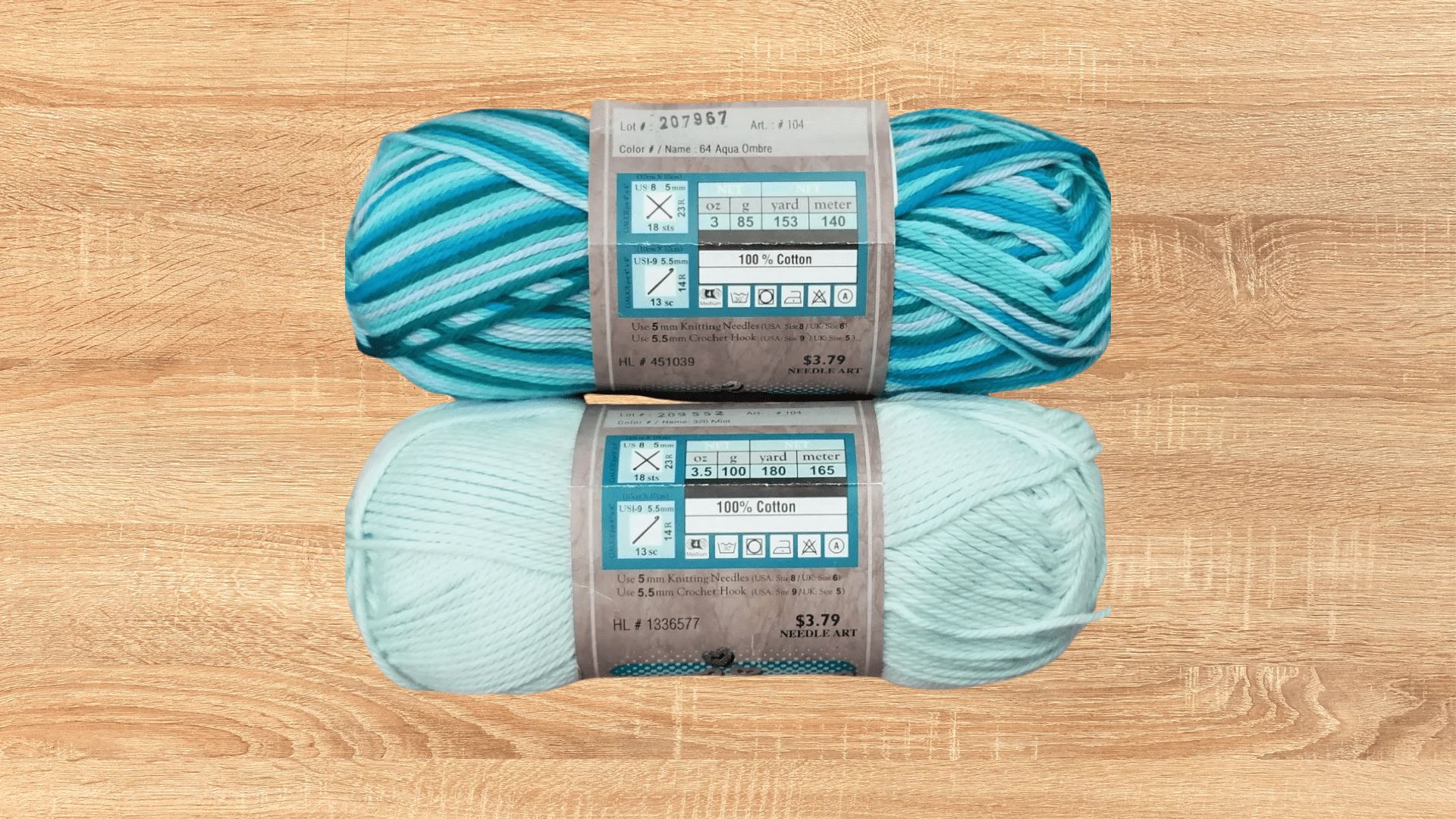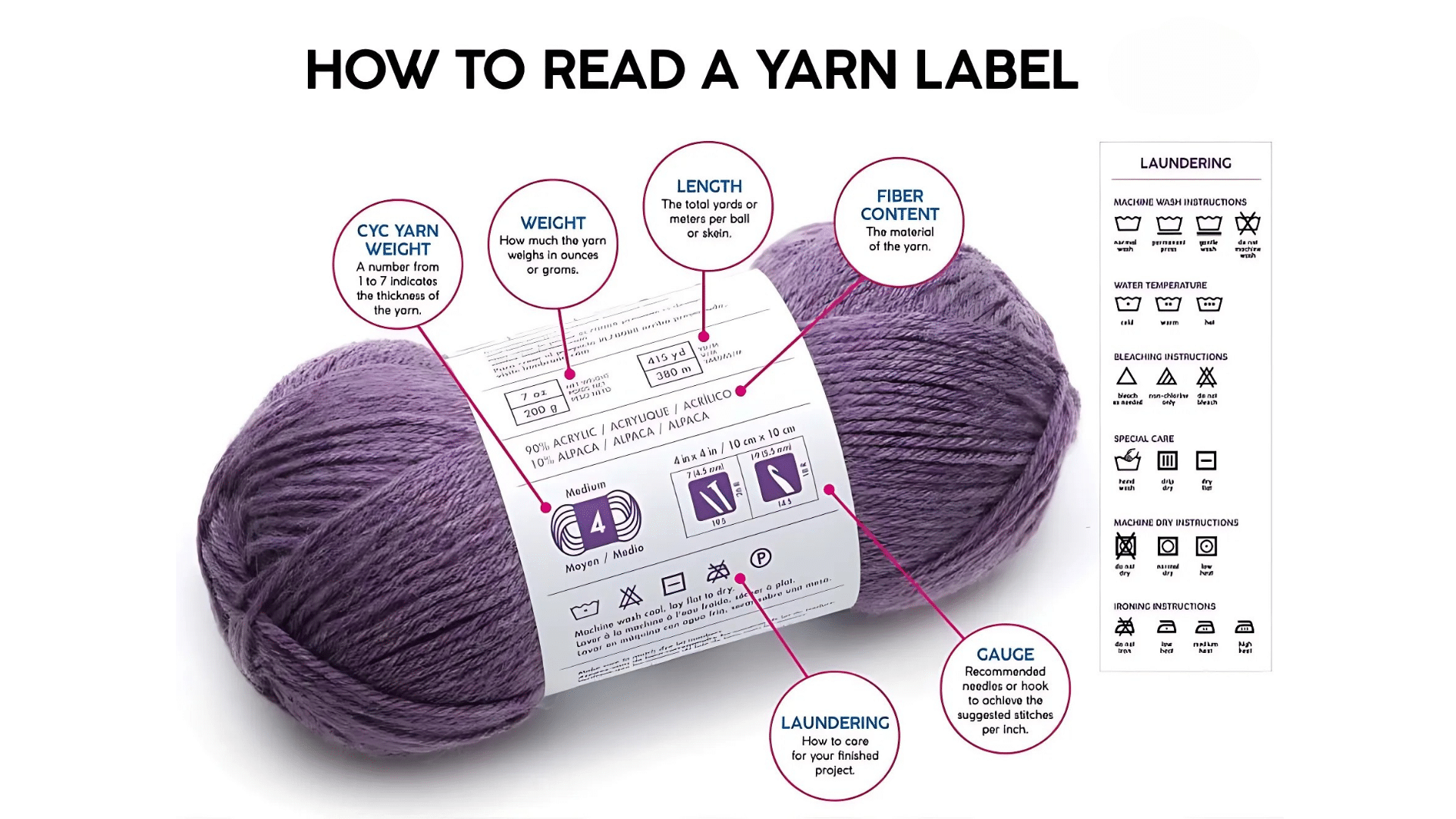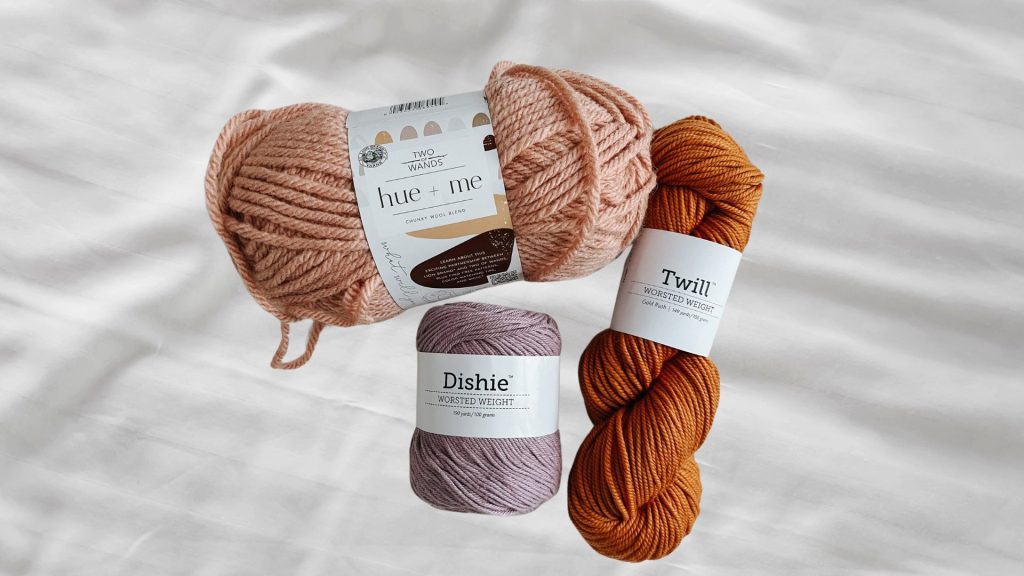When you buy yarn, the label has a lot of important information that can help you choose the right one for your project. It tells you about the fiber content, weight, recommended needle size, yardage, and care instructions. Learning how to read a yarn label can save you time and make sure your finished piece turns out just right.
Each yarn label includes details like gauge, dye lot, and washing instructions, which can affect how your project looks and feels. If you don’t pay attention to these details, you might end up with yarn that doesn’t match your pattern or doesn’t work well for your project.
In this guide, I’ll tell you how to read a yarn label step by step. Whether you’re a beginner or an experienced crafter, understanding yarn labels will help you make better choices and avoid common mistakes. Let’s get started!
Why Understanding Yarn Labels Is Important

Reading a yarn label might not seem like a big deal, but it can save you time, money, and frustration when starting a knitting or crochet project:
1. Helps You Pick the Right Yarn for Your Project: Every project needs a specific yarn weight, fiber, and texture. A soft cotton yarn might be great for summer tops but not warm winter scarves.
2. Ensures Your Project Turns Out the Right Size: The label gives you gauge information, which tells you how many stitches and rows fit into a certain space. Matching this helps your project come out the right size.
3. Prevents Color Differences: Buying yarn from the same dye lot ensures your project has a consistent color. Mixing different dye lots can lead to slight color variations.
4. Tells You How Much Yarn You Need: Checking the yardage and weight on the label helps you buy the right amount. Running out of yarn mid-project can be frustrating, especially if the store runs out!
5. Gives You Care Instructions: Some yarns are machine-washable, while others require hand washing. Following the label’s care instructions keeps your project looking good for years.
By taking a few minutes to read the yarn label, you can avoid common mistakes and make sure your project turns out great!
How to Read a Yarn Label

A yarn label might look like a small tag, but it holds a lot of useful information. Learning how to read it can help you choose the right yarn for your project, avoid mistakes, and make sure your final piece turns out just the way you want.
1. Brand and Yarn Name
Every yarn label will include the brand name (like Lion Brand, Red Heart, or Bernat) and the specific yarn name (such as Wool-Ease or Simply Soft). This helps you identify the yarn if you need to buy more later.
Why it matters:
- If you need more yarn, knowing the exact name makes it easier to find the same type.
- Different brands offer different textures and fiber types, so this helps you choose what fits your project best.
2. Fiber Content
The fiber content tells you what the yarn is made of. Common fibers include:
- Cotton: Soft, breathable, and great for washcloths, summer wear, and baby items.
- Wool: Warm and stretchy, perfect for winter garments and blankets.
- Acrylic: Budget-friendly, easy to care for, and works well for many projects.
- Blends: A mix of fibers, combining their best qualities (like wool-acrylic for warmth and durability).
Why it matters:
- Fiber affects texture, stretch, durability, and warmth.
- Some fibers are machine-washable, while others require hand-washing.
3. Yarn Weight and Thickness
The weight category of yarn refers to its thickness. Yarn labels often include a number and a description, such as:
- 0: Lace (Very thin, used for delicate shawls)
- 1: Super Fine (Lightweight, good for socks and baby clothes)
- 2: Fine (Slightly thicker, used for lightweight garments)
- 3: Light (Great for summer tops, scarves, and baby items)
- 4: Medium (Most common, used for sweaters, hats, blankets)
- 5: Bulky (Thicker yarn for warm blankets and quick projects)
- 6: Super Bulky (Extra thick for chunky scarves and blankets)
- 7: Jumbo (Extremely thick, used for arm knitting)
Why it matters:
- Yarn weight affects the look, feel, and drape of your finished piece.
- Using the wrong weight can make your project too stiff or too loose.
4. Recommended Needle and Hook Sizes
Most yarn labels list the recommended knitting needle and crochet hook sizes for that yarn. For example, a medium-weight (worsted) yarn might suggest size 8 knitting needles (5mm) or a size H-8 (5mm) crochet hook.
Why it matters:
- It helps you choose the right tools for your project.
- Ensures your stitches are the correct size and tension.
- You can adjust sizes slightly depending on how tightly or loosely you knit or crochet.
5. Gauge or Stitch Count
Gauge refers to how many stitches and rows fit in a 4×4 inch (10×10 cm) square. This is often shown on the label as a small grid with numbers.
Why it matters:
- It helps you match the size and shape of your project to the pattern.
- If your gauge is too loose or tight, your project may come out too big or too small.
6. Yardage and Weight of the Skein
Yarn labels include the total length (yardage/meters) and weight (ounces/grams) of the skein. Some yarns are heavier but shorter, while others are lighter and longer.
Why it matters:
- It helps you calculate how much yarn you need for your project.
- If you run out of yarn, make sure to buy the same brand, type, and dye lot.
7. Dye Lot and Color Number
Dye lots refer to the batch in which the yarn was dyed. Even if two yarns have the same color name, slight differences can occur between dye lots.
Why it matters:
- If you need multiple skeins, buy them from the same dye lot to avoid slight color mismatches.
- Some labels print a color number instead of a dye lot if the yarn is always the same shade.
8. Care Instructions
Yarn labels include washing, drying, and ironing instructions using small symbols. Here’s what they mean:
- A tub of water: Can be machine-washed (hand inside the tub = hand wash only).
- A triangle: Bleach is safe to use. If it’s crossed out, don’t use bleach.
- A square with a circle: Can go in the dryer. If it has an X, lay it flat to dry.
- An iron symbol: Safe for ironing. If crossed out, don’t iron.
Why it matters:
- Some yarns require special care to avoid shrinking or damage.
- Acrylic yarn is usually machine-washable, while wool often needs hand-washing.
9. Extra Information
Some yarn labels include extra details like:
- Lot number: Useful in case you need to order more later.
- Origin: Tells you where the yarn was made.
- Certifications: Some labels mention organic, eco-friendly, or fair-trade certifications.
Reading a yarn label may seem overwhelming at first, but once you understand each section, choosing the right yarn for your project is much easier. The fiber, weight, gauge, yardage, and care instructions all affect how your final piece will look and feel. Before starting a new knitting or crochet project, check the yarn label for a few minutes.
How to Substitute Yarn Using Label Information
Sometimes, the yarn recommended in a pattern isn’t available, but you can find a good substitute by reading the yarn label carefully.
Yarn Substitution Chart
| USA | Name | UK | Australia | Metric Hook Size |
|---|---|---|---|---|
| 0 | Lace Weight | 1 ply | 2 ply | 1.5–2.25 mm |
| 1 | Fingering / Sock | 2 ply / 3 ply | 3 ply | 2.25–3 mm |
| 2 | Sport Weight | 4 ply | 5 ply | 3.0–4.0 mm |
| 3 | DK / Light Worsted | DK | 8 ply | 3.5–5.0 mm |
| 4 | Worsted Weight | Aran | 10 ply | 5.0–6.5 mm |
| 5 | Bulky | Chunky | 12 ply | 6–9 mm |
| 6 | Super Bulky | Super Chunky | 14 ply | 8 mm and larger |
Yarn Substitution Tips
| Step | Tip | Description |
|---|---|---|
| 1 | Match the Yarn Weight | Check the weight category on the label (Lace, Fingering, Worsted, Bulky, etc.). Using a yarn that’s too thick or too thin can change the size and look of your project. |
| 2 | Compare Yardage and Skein Weight | Some yarns are heavier but shorter, while others are lighter but longer. Make sure the new yarn has a similar yardage to avoid running out. |
| 3 | Check the Fiber Content | Different fibers behave differently—wool is stretchy, cotton doesn’t stretch, and acrylic is lightweight. Choose a fiber that behaves like the original yarn. |
| 4 | Look at the Gauge | Check the stitches per inch (gauge) on the label. If the new yarn has a different gauge, you may need to adjust your needle size. |
| 5 | Do a Test Swatch | Always knit or crochet a small sample with the new yarn. This helps you see if the fabric matches your pattern’s texture and size. |
By following these steps, you can find a great yarn substitute without ruining your project!
Common Mistakes When Reading Yarn Labels
Yarn labels give you important details about your yarn, but if you miss key information, your project might not turn out as expected. Here are some common mistakes to avoid:
1. Ignoring Yarn Weight: Not all yarns are the same thickness! Using a different weight than your pattern calls for can make your project too big or too small.
2. Skipping the Gauge Information: If you don’t check the stitches per inch (gauge) on the label, your knitting or crochet piece might not match the pattern’s size.
3. Not Checking Fiber Content: Different fibers behave differently. Wool is warm and stretchy, while cotton is sturdy but doesn’t stretch. Choosing the wrong fiber can affect texture, durability, and comfort.
4. Mixing Different Dye Lots: Even if two skeins look the same, slight color differences can appear if they come from different dye lots. Always check and buy enough yarn from the same lot.
5. Ignoring Yardage: Just because two skeins look the same doesn’t mean they have the same length. Always check the yardage so you buy enough yarn for your project.
6. Forgetting About Care Instructions: Some yarns require hand washing, while others are machine-washable. Not following the label’s care guide can lead to shrinking, fading, or damage.
By reading yarn labels carefully and avoiding these mistakes, you can choose the best yarn for your project and get great results!
Conclusion
Understanding how to read a yarn label is one of the best skills you can learn as a knitter or crocheter. The label gives you everything you need to know about the yarn—its weight, fiber content, gauge, yardage, and care instructions.
By paying attention to this information, you can choose the right yarn for your project and avoid common mistakes like picking the wrong weight, mixing dye lots, or not buying enough yarn.
A few minutes to check the label can save you time, money, and frustration later. It helps ensure your project turns out how you want, no matter what you plan to make.
Frequently Asked Questions
What does yarn weight mean?
Yarn weight refers to how thick or thin the yarn is. It ranges from Lace (0) to Jumbo (7) and affects how your finished project will look and feel.
How do I know how much yarn to buy?
Check the yardage (length in yards/meters) on the label. Compare it with your pattern’s requirements to make sure you buy enough skeins.
What do the care symbols mean?
Care symbols show if the yarn is machine-washable, needs hand washing, or should be laid flat to dry. Following these instructions helps your project last longer.
Why do some labels show a square with numbers inside?
This is the gauge swatch and tells you how many stitches and rows fit in a 4-inch (10 cm) square using the recommended needles or hooks.









